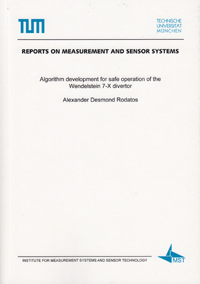
Shop : Details
Shop
Details

November 2017
Alexander Desmond Rodatos
Algorithm development for safe operation of the Wendelstein 7-X divertor
In the frame of this thesis, an algorithm to monitor the state of actively cooled plasma facing components at the Wendelstein 7-X divertor was developed. The actively cooled components of the divertor consist of two parts, a water cooled copper structure and carbon fiber reinforced carbon tiles as armor. A critical part is the interface between the carbon tiles and the cooling structure. Microscopic cracks can develop inside this interface when the divertor components are overloaded. Growing cracks drastically reduce the heat transport between the carbon tile and the cooling structure resulting in higher surface temperatures. To prevent damage to the machine and lengthy repairs these cracks, so called delaminations, need to be detected and monitored. Therefore, each divertor of Wendelstein 7-X will be monitored by an infrared camera with the aim to detect delaminations during the experiments.
At first, a criterion, based on the transient development of the surface temperature, is developed to determine if an interface is intact or delaminated. Data from previous experiments with known delaminations and finite element method calculations are used to study the behaviour of components with delaminated and intact interfaces. A common occurrence in fusion devices, that could hamper the detection of delamination, is the formation of surface layers on plasma facing materials. Dedicated experiments with artificially created surface layers were performed to test the robustness of the criterion against the formation of surface layers. From these experiments, an additional criterion for the detection of surface layers was deduced. Based on the two found criteria, a prototype algorithm to detect defect interfaces was developed, utilizing the parallel processing capacity of general purpose graphic processing units. The performance of the algorithm was determined with help of old experimental data from the GLADIS device and the Tore Supra Tokamak. The algorithm was capable of detecting delaminations in both cases.
At first, a criterion, based on the transient development of the surface temperature, is developed to determine if an interface is intact or delaminated. Data from previous experiments with known delaminations and finite element method calculations are used to study the behaviour of components with delaminated and intact interfaces. A common occurrence in fusion devices, that could hamper the detection of delamination, is the formation of surface layers on plasma facing materials. Dedicated experiments with artificially created surface layers were performed to test the robustness of the criterion against the formation of surface layers. From these experiments, an additional criterion for the detection of surface layers was deduced. Based on the two found criteria, a prototype algorithm to detect defect interfaces was developed, utilizing the parallel processing capacity of general purpose graphic processing units. The performance of the algorithm was determined with help of old experimental data from the GLADIS device and the Tore Supra Tokamak. The algorithm was capable of detecting delaminations in both cases.
Keywords: Kernfusion; Stellarator; Divertor
Reports on Measurement and Sensor Systems
Edited by Prof. Dr.-Ing. Alexander W. Koch, München
Export of bibliographic data
Shaker Verlag GmbH
Am Langen Graben 15a
52353 Düren
Germany
Am Langen Graben 15a
52353 Düren
Germany
Mon. - Thurs. 8:00 a.m. to 4:00 p.m.
Fri. 8:00 a.m. to 3:00 p.m.
Fri. 8:00 a.m. to 3:00 p.m.
Contact us. We will be happy to help you.

